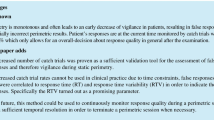Abstract.
Background: To evaluate the effect of response-acquisition technique on psychometric performance in visual-field testing, the conventional one-button yes/time-out method was compared with a two-button yes/no method for responding whether or not the stimulus was detected. There are a number of situations in which the single-button technique leads to ambiguous results. In this study, we thus expected the yes/no method to reduce tendencies towards habituation and automatic responding. Our hypothesis was that the two-button technique could reduce the rate of erroneous responses. Methods: Luminance-difference sensitivity for bright stimuli (32') on a photopic background was evaluated at 26 locations within the central visual field (30°) using a specially equalised video display unit and a modified 4/2-dB staircase strategy (six reversals, maximum-likelihood threshold estimation). Sixty-one ophthalmologically normal subjects (aged 20–30 years) were examined twice with each method. Results: Mean sensitivities with the two-button yes/no method were found to be, on average, 0.13 dB above those measured with the one-button yes/time-out technique – a difference without clinical relevance. Within-subject variability did not differ between the two methods. However, the less intuitive two-button yes/no method had a slightly higher number of false responses in catch trials. Conclusion: Compared to the conventional one-button yes/time-out method, the two-button yes/no method in normal young subjects thus showed little difference in mean sensitivities and equivalent within-subject variabilities. Concerning our initial hypothesis, the yes/no method is of somewhat higher complexity and is not able to reduce the rate of erroneous responses. The one-button yes/time-out method fared a little better in error rate. In summary, the yes/no method is an alternative and additional possibility of response acquisition in visual-field testing, which is worthy of being tested in a clinical study with elderly subjects.
Similar content being viewed by others
Author information
Authors and Affiliations
Additional information
Electronic Publication
Rights and permissions
About this article
Cite this article
Lutz, S., Dietrich, T. ., Benda, N. et al. An explicit no response instead of time-out in automated visual-field testing. Graefe's Arch Clin Exp Ophthalmol 239, 173–181 (2001). https://doi.org/10.1007/s004170000243
Received:
Revised:
Accepted:
Issue Date:
DOI: https://doi.org/10.1007/s004170000243




